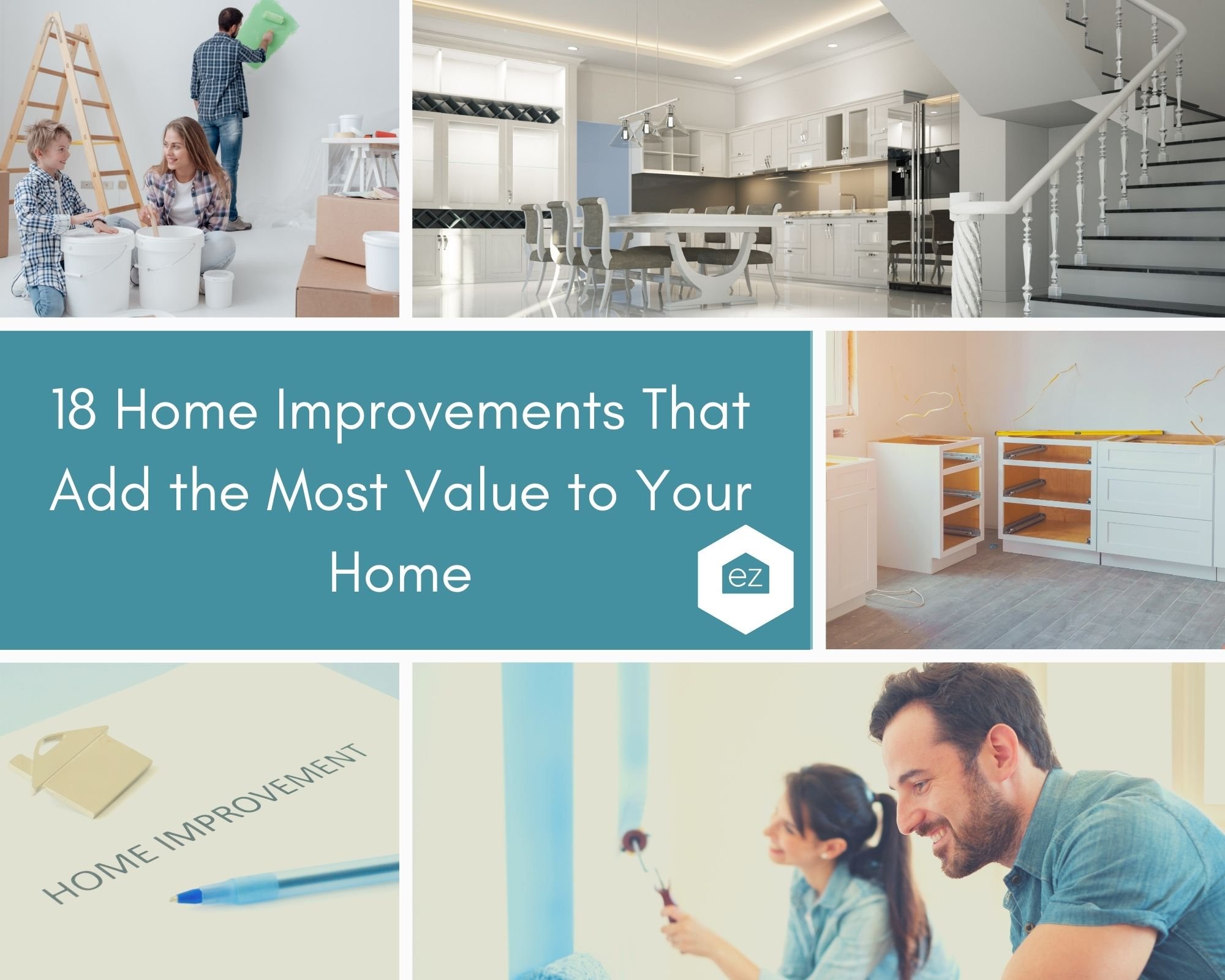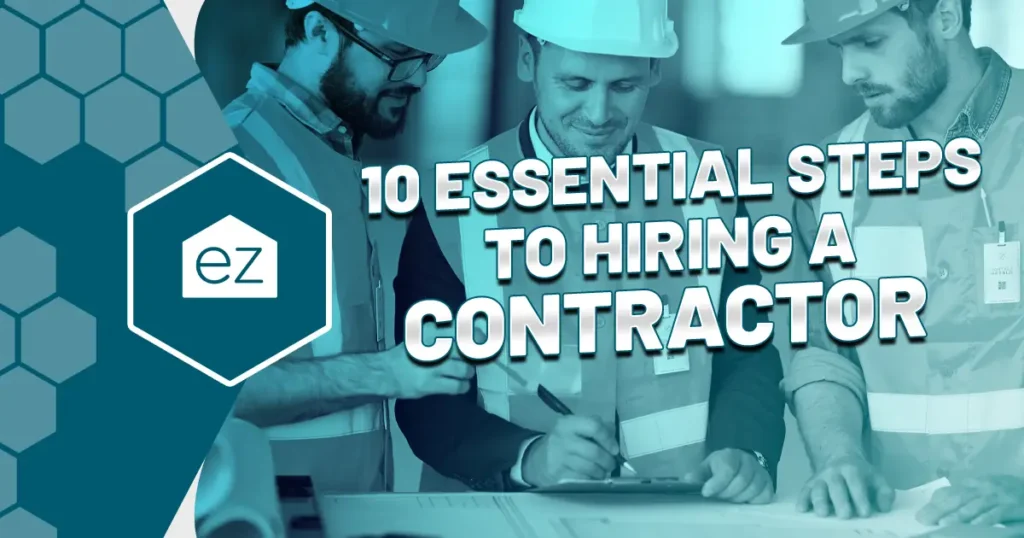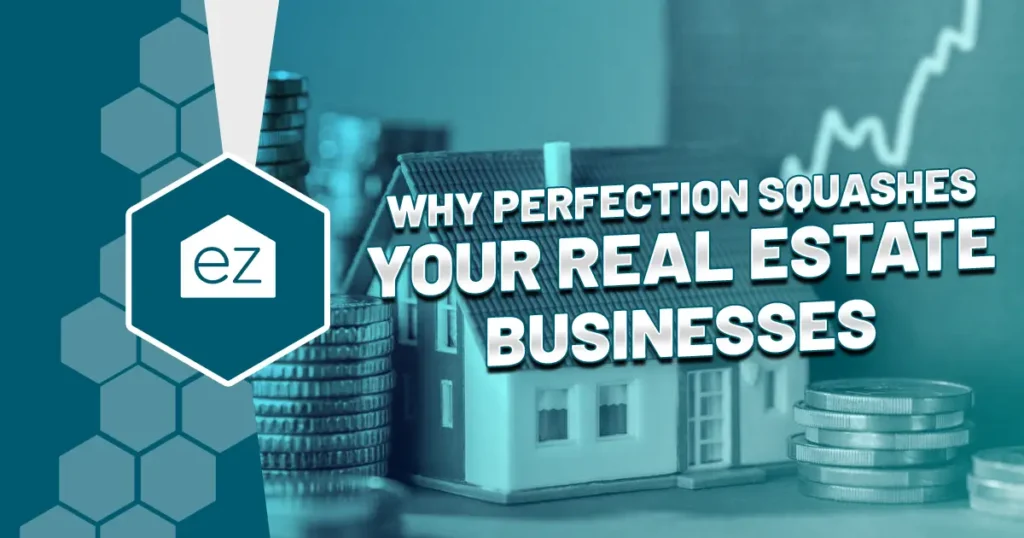18 Home Improvements That Add the Most Value to Your Home
18 Home Improvements That Add the Most Value to Your Home
If you’re looking at completing some home improvements, now may be the right time to start. Take advantage of the remaining warm summer days to do essential home maintenance and other upgrades.
Essential maintenance and upgrades are important for any home. Buying a home means investing time, effort, and money — it is only fitting that you take care of your most significant investment.
There are plenty of home improvement projects that are worth taking on. Not all home improvement projects are equal, though. Some are easier, while others are much more difficult.
Most importantly, some add more value to your home. Whether you plan on selling your home immediately or keeping it indefinitely, it is always wise to continue to make changes that could potentially raise the value of your home.
Here are several home upgrades worth considering to maximize your return on investment and overall enjoyment of your home.
Exterior Home Upgrades
If you want to maximize the beautiful summer weather for your home improvement projects, then it’s best to start outside. After all, you can still comfortably work on interior renovations even in cold weather.
Exterior home improvements aren’t limited to updating your roofing or landscape. Window and door replacements count as exterior upgrades, too.
Exterior home upgrades are vital if you want to sell your house as soon as possible. These projects help raise not only your home value but also your curb appeal or potential buyers’ first impressions of your home.
Over the past five years, exterior home upgrades are consistently among the top five remodeling projects with high ROI.
Garage Door Replacement
Average cost: $4,000
Return on investment: Over 93% ROI
Garage door replacements have topped Remodeling Magazine’s National Cost vs. Value lists since 2018. This year, the magazine estimates that homeowners recoup 93.8% of their renovation budget upon house resale.
If you already have a motorized garage door opener, upgrading your garage door becomes much cheaper. Popular garage door trends you may consider are steel garage doors for a low-maintenance option and glass-paneled garage doors for a clean, contemporary look.
There are several benefits to replacing your home’s garage door. A new garage door helps you stay on top of home design trends, thus boosting your curb appeal.
Aside from that, replacing your garage door can help you reduce your energy costs. Old garage doors are more likely to leak out air and heat, making your home less energy-efficient, especially during winter.
Manufactured Stone Veneer Siding
Average cost: More than $10,000(Dependant on home size and location)
Return on investment: Around 92% ROI
Upgrading your house siding using manufactured stone veneers is another mainstay in many home improvement lists with the best ROI. Since 2018, manufactured stone veneer exteriors are estimated to recoup more than 90% of your budget, even reaching as high as 97% a few years ago.
Premium stone veneers are virtually impossible to tell apart from natural stone but are much cheaper. You get to enjoy high-quality veneer and raise the aesthetic appeal of your house exteriors without paying a premium price.
Moreover, you don’t have to add these stone veneers to your whole exterior walls. Installing it on key areas, such as front entrance archways, and at half-wall height looks beautiful already. The difference in texture from the upper and lower halves of your house facade provides contrast and further raises curb appeal.
Aside from manufactured stone veneers, other house siding upgrades offer high ROI. Fiber-cement and vinyl siding replacements provide 69% and 68% ROI, respectively.
Backyard Deck Addition
Average cost: Over $16,500
Return on investment: Almost 66% ROI
Part of adjusting to the new normal brought on by the COVID-19 pandemic is practicing social distancing and avoiding being away from home as much as possible. Due to this, many homeowners turned to build decks to get some outdoor time while remaining safe in their own homes.
Forbes noted that contractors and architects reported increased demand for decks, patios, and other outdoor living area upgrades over the past year. Decks and patios can be used for safe, socially distanced gatherings with friends and relatives.
Take note that your chosen materials affect how much costs you can recoup. If you want to maximize your ROI, then pressure-treated wood is the best material to use.
Although using composite deck materials allow you to recoup 63.2% of your budget, using wood lets you recover almost 66% of the costs.
Roofing Replacement
Average cost: More than $15,000 for asphalt roofing
Return on investment: Almost 61% ROI
Repairing and upgrading your home’s roof is always a highly recommended home improvement project. Roofing replacements and repairs are even more critical if you live in areas that receive lots of rainfall or are prone to experiencing hurricanes.
Roofs in those areas are more likely to get worn down faster. If you decide on replacing your roofing material, go for durable and weather-resistant materials like asphalt or metal.
Remodeling Magazine recommends using fiberglass asphalt shingles with felt or synthetic underlayment. Such a project can set you back by an average of $28,256 but allow you to recoup $17,147 if you sell your house.
Metal roofing replacements are a great option, as well, offering around 56% ROI. However, replacing your roof with metal is heavier on the budget. It can cost you almost $50,000 and recoup nearly $26,000.
Landscaping Upgrades
Average cost: At least $3,500
Return on investment: Historically 100% ROI at resale
Landscaping your front yard is one of the most popular ways to boost your home’s curb appeal. More than 94% of real estate agents say that better front yard landscaping helps raise your house’s ability to sell quickly.
Moreover, at least 75% of real estate agents noted that houses with beautiful landscaping could be worth between 1% to 10% more than ones with no landscaping. That is equivalent to at least $2,600 to $26,000 per house with an average price of $266,000.
If you are tackling your home’s landscaping yourself, here are some tips to ensure a beautiful yet budget-friendly front yard.
- Plant easy-to-maintain perennials and shrubs to avoid dead or withered plants.
- Choose low-maintenance plants and plants native to your area to ensure their growth.
- If you live in areas with cold winters, look for freeze-proof plants or those that can grow back even after a harsh winter.
- If you live in areas with dry climates, choose succulents and other drought-resistant plants.
Interior Home Upgrades
If you aren’t able to get your home upgrades finished in time before the cool fall weather kicks in, don’t worry just yet. It may depend on the type of project, but fall months are generally low seasons for contractors.
These include concrete workers, painters, and kitchen remodelers. Hiring contractors during their slow months can help their business. You might also get some seasonal discounts, too!
Working on interior home upgrades might also be better for you and your contractors. This way, you’ll all be warm inside rather than freezing outdoors.
Although most home upgrades that offer the best ROI are exterior projects, interior home improvements are two constant high-placers on various lists.
Minor Kitchen Upgrade
Average cost: Around $26,000
Return on investment: Over 72% ROI
Kitchen remodels are popular recommendations for homeowners who want to improve their resale value and improve the overall quality of life at home. After all, kitchens are one of the most used rooms of the house.
The heat from cooking, water pipes that are prone to damage, and cooking materials or ingredients that can ruin countertops also mean kitchens are one of the most easily worn down parts of any home.
If you have a limited budget and cannot or do not want to do a complete kitchen remodel, limit your upgrades to the critical areas first. If you stick to your budget, you can recoup over 72% of your total costs.
Remodeling Magazine recommends replacing laminate countertops and installing a mid-priced sink and faucet. They also recommend replacing the flooring. Make sure to use resilient flooring materials, like floating vinyl planks, ceramic, and other tile options.
A new coat of paint on the walls and the ceiling can make your kitchen look like a whole new place.
Bathroom Upgrades
Average cost: More than $24,000
Return on investment: Around 60% ROI
Like kitchens, bathroom remodels are very popular home upgrades. Again, like kitchens, the water pipes and constant use of bathrooms make it more susceptible to damage and need repairs.
You can maximize your bathroom home upgrades by sticking to a midrange budget, as well. Although bathrooms are much smaller than kitchens, renovating one can cost as much or even more than your kitchen.
A mid-range bathroom remodel gives you around 60% ROI. If you can stick to a budget of $24,000, you can recoup just under $15,000. In an ideal full master bathroom remodel, you can replace all the bathroom flooring and bathroom fixtures, add a tile shower, and a new tub if room allows.
Other options you can do are install a solid-surface vanity counter and sink and put in a recessed medicine cabinet with matching lights.
Home Office Addition
Average cost: Between $2,600 to $7,800
Return on investment: Around 87% ROI
Just like decks and patios, home offices surged in popularity over the past year. As 75% of American employees started working from home in 2020, having a dedicated office space became more important — especially for those living with kids.
You don’t have to worry about home offices becoming defunct or unnecessary once the pandemic ends, either. According to a Zillow survey, most workers would prefer to continue their work-from-home setup even after the pandemic.
The cost of your home office renovation would depend on what you want to put in the room. Naturally, you will need a larger budget for custom or built-in desks, shelves, and cabinets.
Here are a few essential things to consider for your home office project:
- Make sure the room has enough wall outlets.
- Consider custom wall outlets with ports of USBs and other chargers.
- Make certain the room is hard wired for internet and telephone.
- Install bright overhead and ambiance lighting.
- Pick a room that receives a lot of natural light or open up space for a large window.
- Create a well-lit dedicated “Zoom space” or an area with an excellent, clean background for any video conferencing calls.
Master Suite Addition
Average cost: More than $150,000
Return on investment: Over 54% ROI
Master suite additions may be a costly project, but it offers high returns. A midrange master suite addition costing around $156,000 can recoup almost 55% of the costs. Meanwhile, an upscale version of the project can set you back over $320,000 while offering about 48% ROI.
A 24×16-foot master bedroom suite addition still falls under the mid-range category. This gives you enough space for a small walk-in closet and dressing area, an ensuite bathroom with a soaker tub, a ceramic tile shower, and double sink counters.
Depending on your budget, here are some design ideas to further elevate your master bedroom:
- Install a bay window with banquette seating.
- Choose an eye-catching light fixture.
- Use mirrors and sliding cabinet doors to give the illusion of a bigger space.
- Ensure the room gets a lot of natural light.
- Have a door leading to the backyard or deck.
Hardwood Floor Upgrade
Average cost: Between $1,000 and $2,500 for refinishing
Return on investment: Between 70% to 80% ROI
The state of your home’s floors can make or break a potential sale. Real hardwood floors offer up to 70% to 80% ROI for your home. Just by installing hardwood floors, you can raise your house’s total value by 2.5%.
Upgrading from laminates to hardwood floors can be costly, though. The project can cost anywhere between $6 to $12 per square foot, including material and labor costs. The wood type and flooring style you choose can also bring the price up or down.
Here are a few affordable hardwood floor options:
- Pine: Rustic feel, light beige to golden amber color, starts at $4.50 per square foot
- Bamboo: Hard and durable, pale yellow to green color, starts at $5 per square foot
- Hickory: Ideal for high-traffic areas, wide color variation, starts at $6 per square foot
Simply refinishing existing hardwood floors can also raise your total home value. You may even potentially recoup 100% of the costs upon a successful sale.
Basement Renovation
Average cost: An average of $20,000
Return on investment: Around 70% to 75% ROI
When it comes to home improvements, finishing or renovating your existing basement is always a good idea. A finished basement can put your house in a higher price bracket, thanks to the added heated square footage.
Homeowners typically spend an average of $18,400 to finish an existing basement. However, depending on the materials, decor, and other project requirements, the budget may exceed $30,000. Even with the high costs, the silver lining is that you stand to recover up to 70% of the costs.
Keep your basement renovation costs down by choosing materials carefully and logically. Hardwood floors may be great for the rest of the house but are terrible for basements due to the moisture.
A finished basement can be used as an additional living space, a game area, or a guest bedroom. Another great idea is to turn your basement into an independent living space with a walkout so that you can rent it. If you do decide to rent out your remodeled basement, you can slowly recoup your budget without selling the entire house.
Better Home Efficiency Upgrades
Home improvements that focus on boosting energy efficiency are among the most significant house renovation trends in the past few years. Many homeowners turn to home efficiency upgrades thanks to innovative home systems, greater accessibility to alternative energy sources, and potential tax credits.
Not only that, but energy-efficient homes are also more environmentally friendly and offer healthier, clean living conditions for the residents.
Here are six home upgrades you can do to improve your home’s energy efficiency.
Vinyl Window Replacement
Average cost: Nearly $20,000
Return on investment: Almost 70% ROI
Upgrading your windows improves both your home’s aesthetic appeal and energy efficiency.
An old, drafty, and creaky window is not only terrible to hear and look at, but it can also contribute to higher heating bills. Window drafts can let out up to 30% of your home’s heating or air conditioning, which significantly reduces the efficiency of your HVAC system.
Vinyl windows are ideal replacements for old windows. It offers nearly 70% in returns, and the average project costs are less than $20,000. New wood windows are good options, too. However, it offers a slightly lower ROI at 67% while costing over $20,000.
Front Entrance Upgrade
Average cost: Starts at $2,000
Return on investment: Around 65%
Front door upgrades are instant curb appeal enhancers. You can go as simple as changing the front door material and freshening up the paint job.
Alternatively, you can do a more significant renovation and expand the front entrance. Wider doors with dual sidelights have been one of the front door trends over the past year. This can cost over $10,000, though.
If you have a limited budget and want to improve curb appeal and energy efficiency, switching to a steel door is an option. This project costs a little over $2,000 and offers 65% ROI aesthetically. In terms of energy efficiency, you can yield as much as 100% ROI.
Just like your window upgrades, a new steel door would help you maintain your desired home temperature.
Solar Panels Installation
Average cost: About $16,000
Return on investment: Around 20% ROI in the first year
Installing solar panels is one of the biggest trends in sustainable construction. Having solar panels in your home not only helps you bring down your electricity bill but also offers tax credits as energy-efficient home improvements or upgrades.
Best of all, you don’t have to sell your house to recoup the installation costs. You can cash in on your investment by selling the solar energy back to your local power grid.
And if you are looking to sell your home, you’ll find that over 80% of home buyers now include solar panels and other energy-efficient home additions in their list of must-have features.
Insulation and Sealant Upgrade
Average cost: Around $2,400 for spray foam
Return on investment: Up to 100% ROI
Insulation and sealant upgrades may sound too simple, especially after going over kitchen remodels, solar panel installation, and everything else. As such, many homeowners overlook and neglect such home upgrades.
However, it is a crucial home improvement if you are aiming for better energy efficiency at home. Just like replacing old, drafty windows and doors help improve temperature control inside, so do insulation and sealant upgrades.
There are different types of insulation materials you can choose from. If your goal is to ensure a near-airtight thermal barrier, your best bet is spray foam insulation.
Switch to LED Lights
Average cost: $5 per light bulb
Return on investment: Up to 63% ROI based on energy efficiency alone
LED or light-emitting diode bulbs are nothing new. Many new homes across various states already come with LED lights.
LED light bulbs are the most energy-efficient lighting option. They use over 75% less energy than traditional incandescent light bulbs and last up to 25 times longer. Although LEDs use up less energy, they offer comparable or even brighter light than other light bulbs.
Smart or Programmable Thermostats
Average cost: Between $250 to $350
Return on investment: Around 70% ROI from energy savings
Smart homes are all the rage today. If you haven’t hopped on the trend yet, your best option is to start with programmable or smart thermostats.
Data shows that installing a smart or programmable thermostat can save between 10% to 12% in heating and up to 15% in cooling costs. Other findings note that smart thermostats can save up to 23% overall in heating and cooling.
With this information, customers can potentially save up to $200 from their energy or electricity bills.
Better Homes, Better Life
Many home improvements can bring in high returns and improve your overall enjoyment of living in your home. Make sure to carefully consider each one based on your budget, your needs, and the timing.
Start Your Home Search
Preston Guyton
Share this Post
Related Articles
Real Estate Tips
How to Communicate Your Value As A Real Estate Agent
Real Estate Tips
10 Essential Steps to Hiring a Contractor
Real Estate Tips
Why Perfection Squashes Your Real Estate Businesses
Real Estate Tips






